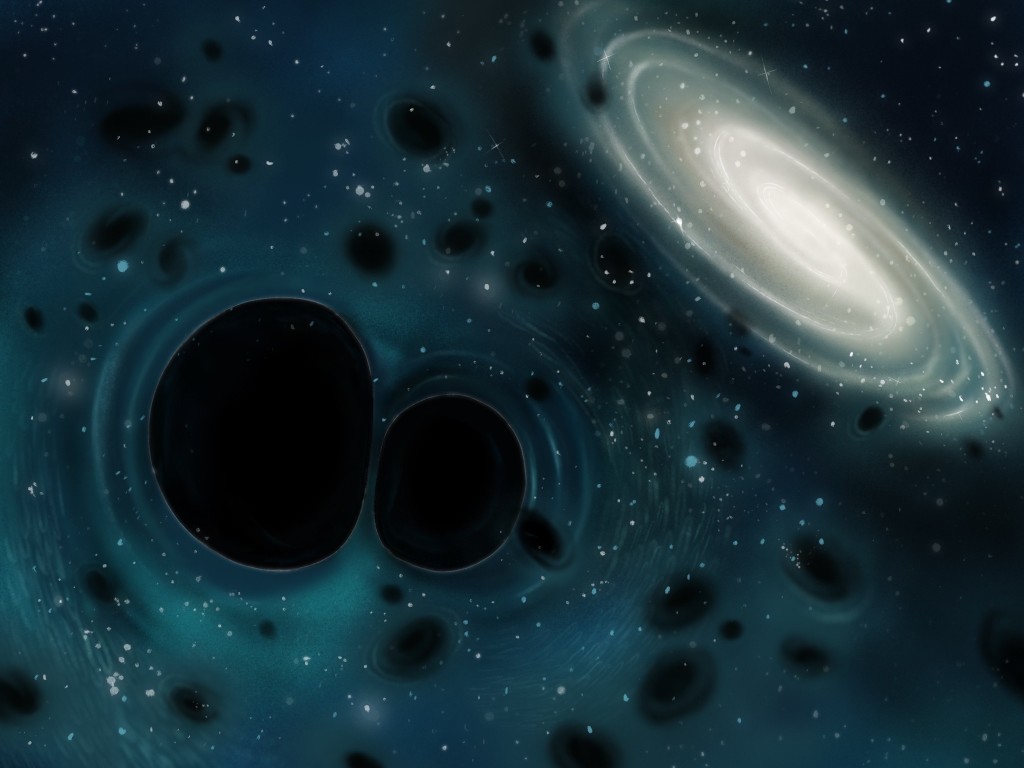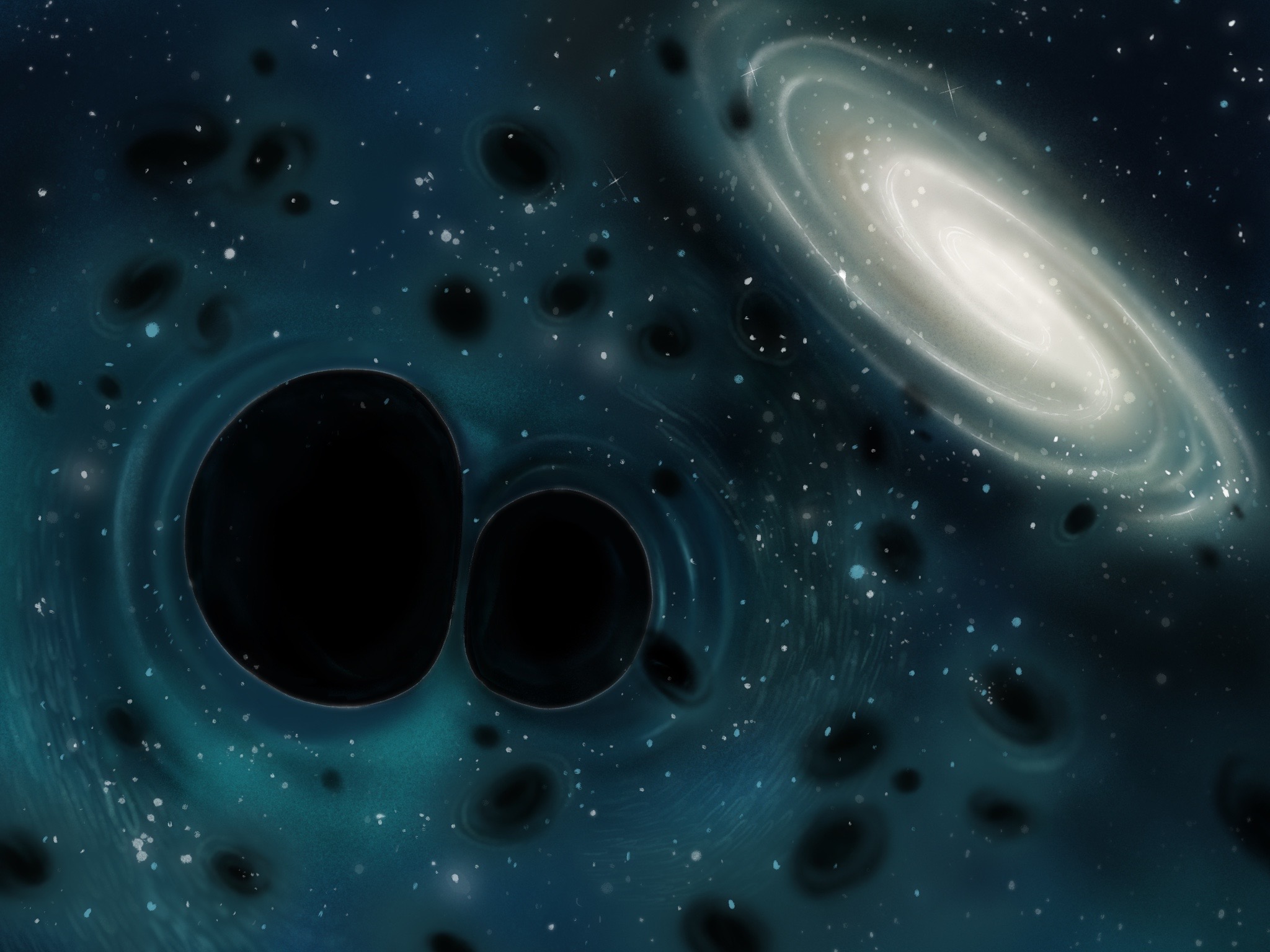OMMEGANG: searching for dark matter with satellites and gravimeters
Brussels, 11 October 2024 – This is not a Brussels folk festival, but a scientific research project. OMMEGANG, an acronym for ‘Observing dark Matter and MEteoroids with Gravimeters ANd GNSS’, is aimed at detecting mini black holes passing close to the Earth using data from GNSS positioning satellites (including the GPS and GALILEO systems) and superconducting gravimeters. These mini black holes could partly explain the enigma of dark matter in the universe. Scientists from the Royal Observatory of Belgium (ROB) and the ULB are involved in this project, which brings together ROB’s expertise in GNSS and gravity measurements and ULB’s expertise in dark matter models and primordial black holes.

Artist’s view of a massive black hole merging into a cluster, probably like GW190521, an observation of gravitational waves by LIGO/Virgo. Credit: Ingrid Bourgault (distributed under a CC BY-SA 4.0 International licence). (Source: https://commons.wikimedia.org/wiki/File:Illu_LIGO-Virgo_20200902_2.jpg)
Dark matter made up of mini black holes?
The existence of dark matter is a hypothesis that could explain the anomalies in the movements of galaxies. Galaxies have been observed to spin much faster than predicted by calculations based on the gravitational attraction of the gases, celestial bodies and stars that make them up. Since gravity is linked to mass, the best explanation for these anomalies would be the presence of an unknown, invisible matter that can only be detected by the effect of gravitation: dark matter.
For more than 40 years, the scientific community has searched in vain for this dark matter and has put forward numerous hypotheses about its structure. Some believe that, on a small scale, it is made up of a collection of dark matter particles that regularly pass through the solar system. However, the size and mass of these hypothetical lumps of matter remain unknown.
Another hypothesis currently in vogue is that this dark matter could also be made up of mini primordial black holes, extremely dense and formed at the beginning of the universe. ‘The idea that black holes could form a fraction of a millisecond after the Big Bang from lumps in the primordial soup dates back to the 1970s and the work of Stephen Hawking and his student Bernard Carr’, explains Sébastien Clesse, cosmologist at the ULB. ‘Such mini black holes could explain the mysterious dark matter of the Universe if their mass is equivalent to that of a mountain or a large asteroid, for a size comparable to that of an atom’.
Detecting mini black holes: a challenge
Although very massive in absolute terms, these mini black holes are virtually undetectable. As Bruno Bertrand (ROB) explains, ‘gravity on these scales is very weak. For example, if a primordial black hole weighing 1014 kg, i.e. one hundred billion tonnes or 20,000 times the mass of the Great Pyramid of Khufu, were to approach us at a distance of 100 m, we would feel a force of one tenth of our weight for a fraction of a second. A very short instant, because these dark matter objects, according to the models, travel 200 km in one second relative to us.
Detecting these mini black holes therefore presents a challenge. Pascale Defraigne, Bruno Bertrand (ROB), Michel Van Camp (formerly ROB, now at the Royal Belgian Institute of Natural Sciences) and Sébastien Clesse (ULB) took part in a study to estimate the limits and possibilities of detecting these objects. The first author of the article, Michal Cuadrat-Grzybowski, a student at the time at ULB and ROB and currently a researcher at TUDelft, is an expert in orbit calculation.
In this study, recently published in Physical Review D, the scientists estimate that, in the vicinity of the Earth, passages of these mini black holes below the Earth-Moon distance, estimated at at least one per decade for the mass of 1014 kg mentioned above, could disrupt the orbits of GNSS (Global Navigation Satellite System) positioning satellites, such as the GPS and Galileo satellites, and create variations in the Earth’s gravity field, detectable by superconducting gravimeters. This is where the OMMEGANG research project comes in.
GNSS and gravity data to the rescue
Satellite orbits, which are known to centimetre precision, are much more sensitive to mass perturbations than planetary orbits. In addition, superconducting gravimeters, capable of measuring gravity to within a hundredth of a billionth of its mean value, could also detect variations in gravity caused by the passage of a dark matter object.
What’s more, GNSS and gravity data are already available. The ROB has long-standing expertise in processing GNSS data and measuring gravity, a science known as gravimetry. The ROB also managed two superconducting gravimeters: one, at Membach (High Fens, Belgium), has produced 28 years of data, and the other, at Rochefort, nearly 10 years.
An interdisciplinary project
The ROB’s expertise has already been used for innovative research in geophysics and fundamental physics. These same data, as well as those from other observatories around the world, will therefore be used for the OMMEGANG project, without the need to build a costly new experiment. As Bruno Bertrand says, ‘This is the art of transforming equipment that is initially intended for another use into a detector for other exciting research!’
It’s also a way of advancing science by bringing together several scientific disciplines. ‘OMMEGANG brings together two complementary areas of expertise from our two institutes,’ says Sébastien Clesse. ‘On the one hand, there is the ULB’s expertise in cosmology and fundamental physics (dark matter, primordial black holes), and on the other the ROB’s expertise in GNSS and gravimetry data. This interdisciplinary project is a novel way of doing science, and we are expecting many fruitful results.
More information
- The Physical Review D publication: M. Cuadrat-Grzybowski et al, Probing primordial black holes and dark matter clumps in the Solar System with gravimeter and Global Navigation Satellite Systems networks, Phys. Rev. D, 110, issue 6, 063029. DOI: https://doi.org/10.1103/PhysRevD.110.063029.
- Brussels Laboratory of the Universe BLU-ULB : https://blu.ulb.be/
- Theoretical Physics Service: https://physth.ulb.be/
- GNSS website: https://gnss.be/
- The Time-Frequency Laboratory website: https://betime.be/
- Gravimetry research at ROB: https://seismologie.be/en/gravimetry

